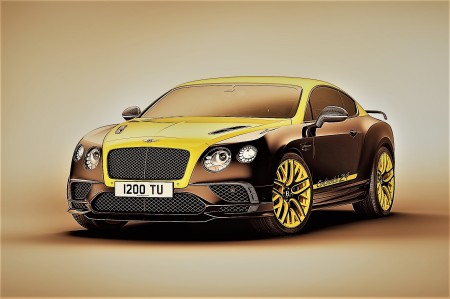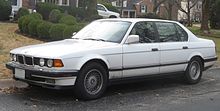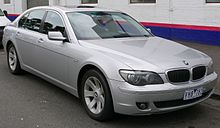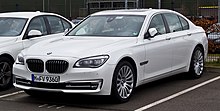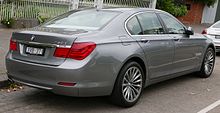| Overview | |
|---|---|
| Manufacturer | BMW |
| Production | 1977–present |
| Body and chassis | |
| Class | Full-size luxury car (F) |
| Body style | 4-door sedan |
| Layout | Front-engine, rear-wheel-drive or four-wheel-drive |
| Chronology | |
| Predecessor | BMW New Six |
The BMW 7 Series is a full-size luxury sedan produced by the German automaker BMW since 1977. It is the successor to the BMW E3 “New Six” sedan and is currently in its sixth generation.The 7 Series is BMW’s flagship car and is only available as a sedan or extended-length limousine. It traditionally introduces technologies and exterior design themes before they trickle down to smaller sedans in BMW’s lineup.The first generation 7 Series was powered by straight-6 petrol engines, and following generations have been powered by straight-6, V8 and V12 engines with both natural aspiration and turbocharging. Since 1995, diesel engines have been included in the 7 Series range.
First generation (1977–1986)
The E23 is the first generation of the 7 Series, produced. Replacing the BMW E3 large sedan, the E23 was produced for ten years from 1977 to 1987 and was replaced by the BMW 7 Series in 1986.
Second generation (1986–1994)
In July 1986,BMW introduced the second generation 7 Series, the E32. Some luxury options included integrated telephone and fax machines, a wine cooler, double glazing, traction control system, and a system that automatically increased spring pressure on the windscreen wipers, to keep them firmly pressed on the glass at Motorway speeds. The top-line E32 750iL was the first car in the world to offer High-Intensity Discharge headlamps.
Initially the engine choices were all six-cylinder petrol, as per the previous generation. In 1987 a V12 engine was introduced. In 1992, V8 engines were added to the lineup (730i and 740i). The E32 (750i) was the first car adhering to BMW’s self-imposed speed limit of 250 km/h (155.37 mph).
The E32 also introduced the extended wheelbase version (indicated by an ‘L’ from German Lang, after the model number) with extra rear leg room compared to the standard 7-series.
Third generation (E38 1994–2001)
The third generation E38 was produced between 1994–2001. It was the first 7-series to be available with a diesel engine and the first to have the option of a five-speed automatic transmission. BMW was also the first European car manufacturer to offer an integrated satellite navigation screen which featured on the E38 7 Series
In the U.S. two engine options were available, a 4.0l (later revised to a 4.4l) V8 (740) and a V12 option (750).
Fourth generation ( 2002–2008)
The fourth generation E65 7 Series was produced from 2001 to 2008 (released as 2002–2008 models). The Hydrogen 7 is the first production BMW to be powered by hydrogen. Although previous generations of the 7 Series had long-wheelbase and protection variants, the E65 was the first iteration to use specific chassis codes for each version. E65 was the designation of the standard-wheelbase version, E66 was the long-wheelbase version, E67 of the high-security (armored) version and E68 of the Hydrogen 7.
The BMW 745i/Li (2002–2005) models featured a 4.4L V8 engine outputting 325 hp. Later on, the BMW 750i/Li (2006–2008) models featured a slightly more powerful 4.8L V8 engine outputting 360 hp. Moreover, the BMW 760i/Li (2002–2005) and 760Li (2006–2008) features a vastly more powerful, performance-tuned 6.0L V12 engine with 438 hp.
The E65 generated more controversy, due to its radical styling and iDrive user difficulties. Nonetheless, the E65 broke records to become the best-selling 7 Series iteration ever, especially after its 2006 facelift. The E65/66 has been a subject of various media forms in pop culture during the early 2000s.
Fifth generation ( 2008–2015)
The fifth generation F01/F02 went on sale in November 2008. The F01/F02 was the first 7 Series available with an 8-speed automatic transmission and all-wheel drive. It is the first 7 Series where all engines are turbocharged (except for markets like Thailand, where the 730Li remains non-turbocharged). The ActiveHybrid7 was the first 7 Series to use an electric motor.
The front suspension is a double wishbone design, instead of the MacPherson struts used on previous generations.
It is in this generation that BMW changed the nomenclature from E to F01, thereby making it the first BMW to have so.
Also the model numbers have been changed for the new engine lineup – 730d/Ld for the 3.0l inline six 258 bhp diesel, ActiveHybrid 7 for the 3.0l inline six 310 bhp petrol hybrid, 750i/Li for the 4.4l V8 473 bhp petrol, 750d/Ld for the 3.0l inline six 385 bhp triple turbo diesel and 760Li for the 6.0l V12 544 bhp petrol.
All the engines are twin turbocharged for maximum efficiency and power.
For 2014 it received BMW’s new second generation iDrive touchpad.
Sixth generation (G11/G12 2016–present)
The sixth generation of the 7 Series was revealed on June 10, 2015 at BMW’s headquarters in Munich. The G11 and G12, which is the codename for the extended wheelbase model, are the first passenger vehicles of BMW to be based on the modular BMW CLAR platform (cluster architecture). As development was heavily focused on reducing weight and increasing structural strength, the body construction uses a combination of carbon-fiber-reinforced polymer (CFRP), high-tensile steel and aluminium. The suspension received air springs at both axles that are adjustable with electronic shock absorbers.
The powertrain line-up consists of a 4.4 litre V8 and three engines from BMW’s modular B-series engine architecture – two 3.0 litre inline-six engines in petrol and diesel form, as well a 2.0 litre inline-four engine for the plug-in hybrid model known as 740e. Initially, each engine will be available with an 8-speed automatic transmission that can be linked with the satellite navigation system.
The G11 is the first 7 Series to feature a plug-in hybrid variant, called the 740e. This new model effectively replaces the rather undersold ActiveHybrid7, which evolved from a 750i based mild hybrid to a 740i based full hybrid in 2014 post-LCI (Life Cycle Impulse) variant. The 740e is marketed as a BMW iPerformance car, not as a member of the BMW i sub-brand.
Notable improvements to the infotainment and driver assistance systems include an automatic parking system that is controllable with a digital key fob and a more intuitive version of the iDrive vehicle operating system, featuring touchscreen input and gesture recognition controls.
The sixth generation 7 Series entered production in June 2015,with European sales being scheduled to begin in October 2015.
-
BMW 740e iPerformance
Also in February 2016, BMW announced the introduction of the “iPerformance” model designation, which will be given to all BMW plug-in hybrid vehicles from July 2016. The aim is to provide a visible indicator of the transfer of technology from BMW i to the BMW core brand. The new designation will be used first on the plug-in hybrid variants of the latest BMW 7 Series, the BMW 740e iPerformance being the first of such plug-in hybrids.

BMW 740e concept plug-in hybrid
The 740e iPerformance was unveiled at the 2016 Geneva International Motor Show, together with the BMW M760Li xDrive (see above) and the BMW i8 Protonic Red Edition special-edition model.Sales of the 740e iPerformance are scheduled to begin by mid-2016. The 740e iPerformance features the same drivetrain as the already launched BMW X5 xDrive40e plug-in hybrid, and has an all-electric range is 25 mi (40 km).
